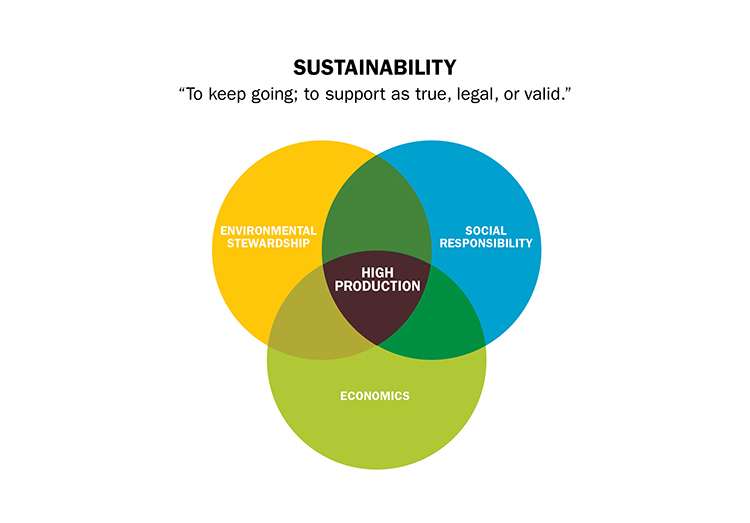
“Where does high production fit into our world, a world that requires sustainability for us to be able to keep going, to support what’s true, legal, and/or valid?”
That question was posed by veterinarian Mark Hardesty during the March Hoard’s Dairyman monthly webinar. Hardesty, a co-owner of the Maria Stein Animal Clinic in Maria Stein, Ohio, discussed factors that go into optimizing milk production.
He shared the following diagram with three circles representing environmental stewardship, social responsibility, and economics. Hardesty pointed out that high milk production falls in the middle of those three circles.

“Our social responsibility is taking good care of our cows,” Hardesty said. “Environmental stewardship means using fewer resources and making more milk per unit.”
He continued, “Then, we have to make money, or we won’t stay in business. That is where it all intersects. It keeps our farm going.”
To support high milk production, Hardesty said major contributors are nutrition, genetics, and cow comfort. “If we get those three things in order, it should result in high production, unless we mess it up somehow,” he said.
Hardesty said mastitis issues that don’t get under control or a lack of cow comfort are two issues that impede production. A lack of reproductive efficiency is another cause. “The whole goal of a reproduction program is to bring cows back in as fresh cows because the first 100 days in milk are when the most profit is generated,” Hardesty explained.
Fresh cow health is also a big part of that. “Fresh cow health translates into better reproduction down the road and directly into high production, because we have to get those cows off to a good start,” he said. Fresh cow health starts with a stress-free calving system, which results in better quality replacements and better fresh cow health.
“Of course, nutrition contributes as well,” Hardesty noted. “Also, genetics directly impact high production, but they also impact replacement quality.” The series of interactions that take place on a farm are significant, he said.
“People ask what is most important for high production; it’s all important. All those details add up,” Hardesty stated. “When we start to get to certain levels of milk production, we start to look for better things in other areas.”
Also presenting during the webinar was Alex Neuenschwander, co-owner and on-site manager for Neu-Hope Dairy near Bluffton, Ind. Their farm works closely with Hardesty to maintain high milk and component production.

“On our farm, we make sure we have all these areas covered. We work closely in systems and in teams,” Neuenschwander explained. “If we don’t have the correct systems in place, we work with our veterinarian to put the correct systems in place, and our people have to implement the systems to make sure we are achieving all our goals.”
To learn more about Neu-Hope Dairy and hear additional advice from Hardesty and Neuenschwander, please watch our March Hoard’s Dairyman webinar, “The details add up to high production.”








